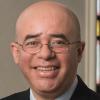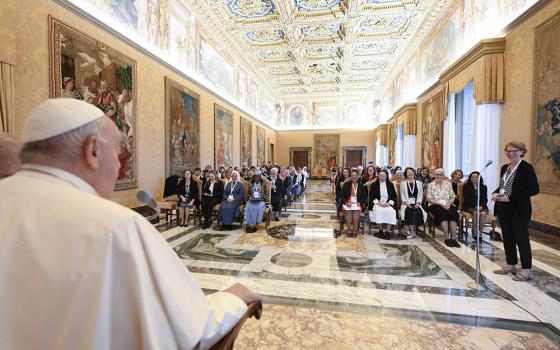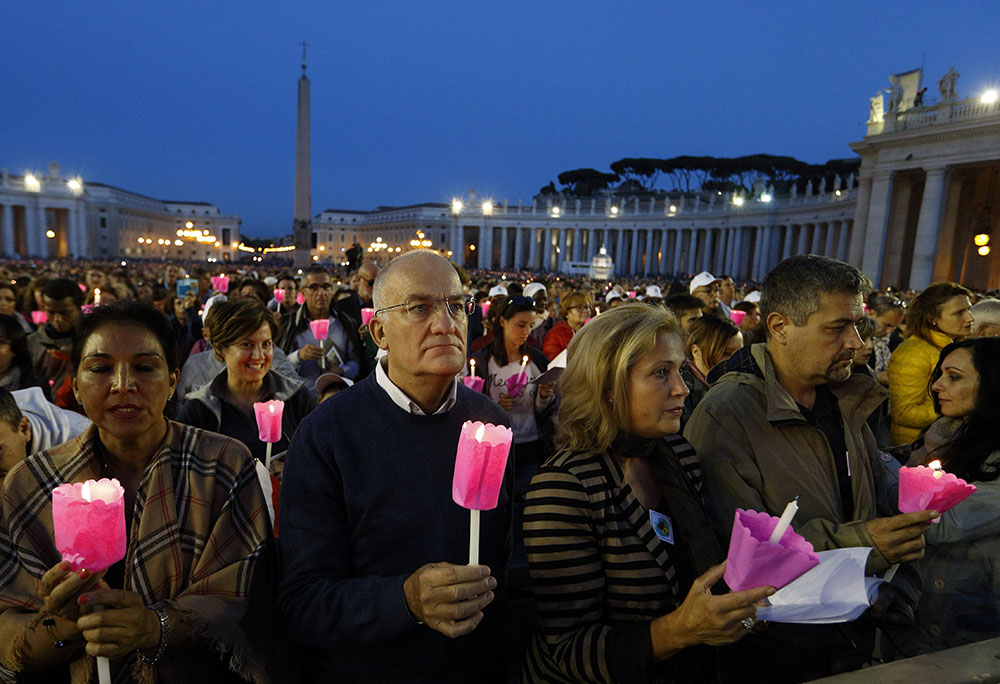
People hold candles during a prayer vigil for the Synod of Bishops on the family attended by Pope Francis in St. Peter's Square at the Vatican Oct. 3, 2015. Francis has said he wants to strengthen the synod process not just for the church but also as a service to humanity. (CNS/Paul Haring)
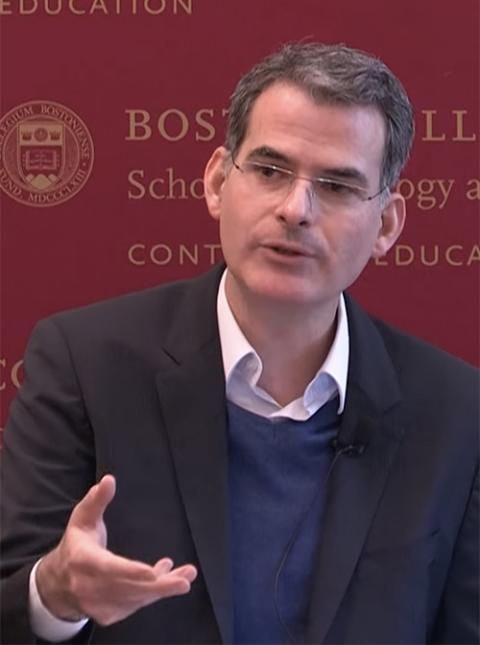
Rafael Luciani (NCR screenshot/YouTube/Boston College School of Theology and Ministry Continuing Education)
My colleague Rafael Luciani is one of the world's leading experts on the topic of synodality, the experience of "walking together" rooted in the spirit of the Second Vatican Council that Pope Francis has called on the Catholic Church to embrace.
Luciani, a native of Venezuela, serves as a theological expert for the regional Latin American Episcopal Council (CELAM) and the Confederation of Latin American Religious (CLAR).
He is also one of three Latin American theologians invited as expert advisers for the theological commission of the secretariat for the next Synod of Bishops. Earlier this year, Francis expanded the upcoming synod: It will begin with a diocesan phase this fall, followed by continental meetings next year, and will conclude with a general assembly at the Vatican in 2023.
Luciani is professor extraordinarius at Boston College and a full professor at the Universidad Católica Andrés Bello in Venezuela.
We spoke earlier this month about synodality, why some Catholics seem reluctant or unwilling to consider this way of being church, and what it means that Xavière Missionary Sr. Nathalie Becquart, his former student, will be the first woman serving as a voting member at a Vatican synod.
Following is our interview, which I translated from Spanish and edited for length and clarity.
Ospino: We hear much about synodality these days. What do you think needs more clarity to understand this topic better?
Luciani: Above all, synodality is a way in which the church is and acts in history. It is not a method of doing things. It is an ecclesial way of proceeding grounded in the ecclesiology of the people of God described in Chapter 2 of Lumen Gentium. According to Cardinal Leo Joseph Suenens, the document's architect, this is the key to interpreting the ecclesiology of the Second Vatican Council. During Francis' pontificate, the reflection on synodality has unfolded as an exercise of deepening the vision of Vatican II.
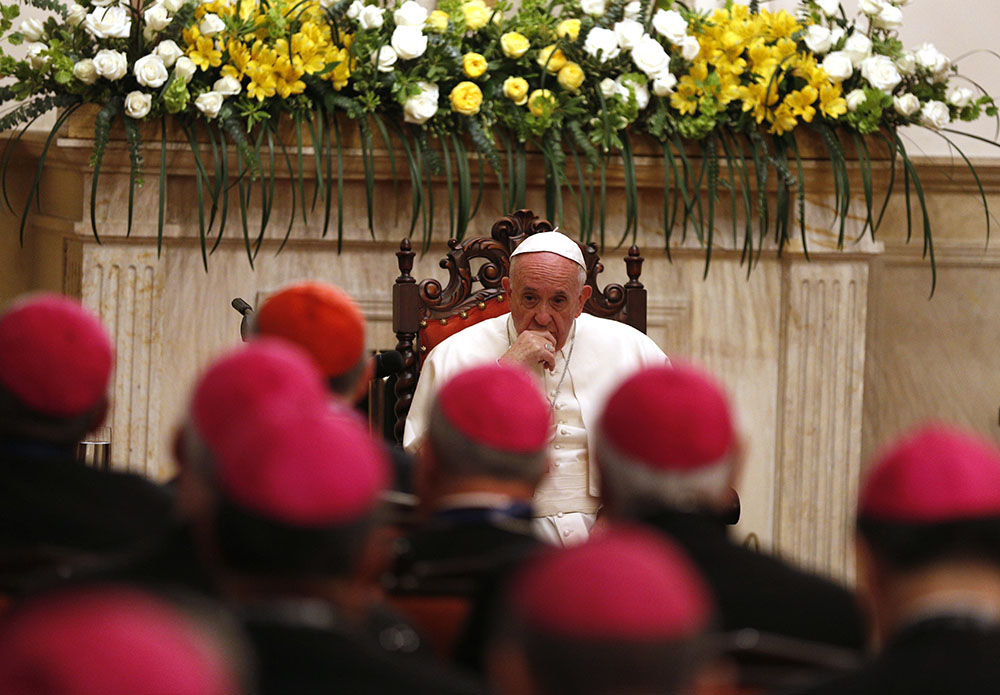
Pope Francis meets with the executive committee of CELAM, the Latin American bishops' council, at the apostolic nunciature in Bogotá, Colombia, Sept. 7, 2017. (CNS/Paul Haring)
More than a drive to reform structures, synodality points to communicational dynamics and ways of relating with one another as baptized people. A synodal vision challenges us to transform clericalist practices in which an individual or a group in the church makes decisions without listening and consulting, as if existing beyond the people of God. Synodality demands that we listen and engage in dialogue to establish binding relationships that build church.
"Binding" means "mutual need," as Lumen Gentium reminds us. It is more than collecting opinions or running surveys. Synodality is an invitation to foster processes of conversion as we listen to one another and to the larger society while reading the signs of the times together.
What is the novelty in the concept of synodality?
Synodality retrieves a more dynamic and inclusive model of being and acting ecclesially. In the first millennium of the Christian tradition, there were many practices from which we can learn much theologically, liturgically and pastorally.
Think of the synodal practice of St. Cyprian, bishop of Carthage: do nothing without the council — of presbyters and deacons — and the consensus of the people. The order is important: take advice from some and build consensus with all as people of God. Consensus presupposes a process of consultation, listening, dialogue and discernment en conjunto (collaboratively). During the second millennium, with the Gregorian Reform and the Council of Trent the attention shifted to uniformity and institutionalization (e.g., parishes, seminaries).
Advertisement
As it unfolds, the synodal model today seeks to achieve some sensus ecclesiae (to feel with the entire church). It is not about limiting or eliminating the decision-making power of the pope or that of the bishops. In fact, it affirms that and strengthens it, demanding that their decisions emerge from sincere consultation and seeking consensus, since every exercise of authority in the church is to be at the service of the people of God.
Synodality empowers the laity in light of our baptism, acknowledging the need for representation in the various structures and processes of ecclesial discernment. More than a numeric representation, it is about including the diversity of cultures, charisms, gifts and ministries.
What ecclesial transformations can we imagine as a result of synodal discernment?
We must be careful not to reduce synodality to a mechanism to change that which we don't like at a given moment, either through the exercise of traditional authority (e.g., a bishop, the pope) or by consultation (e.g., a synodal assembly). Both options would be expressions of a clericalist model: imposition from above.
Synodality invites us to create and institutionalize ecclesial processes that involve the largest possible number of baptized people and seeks to change mentalities. Pope Francis speaks of "pastoral conversion," echoing the general conferences of the Latin American episcopate in Santo Domingo [Dominican Republic, 1992] and Aparecida [Brazil, 2007]. This means that the changes must come from the grassroots, from the local churches.
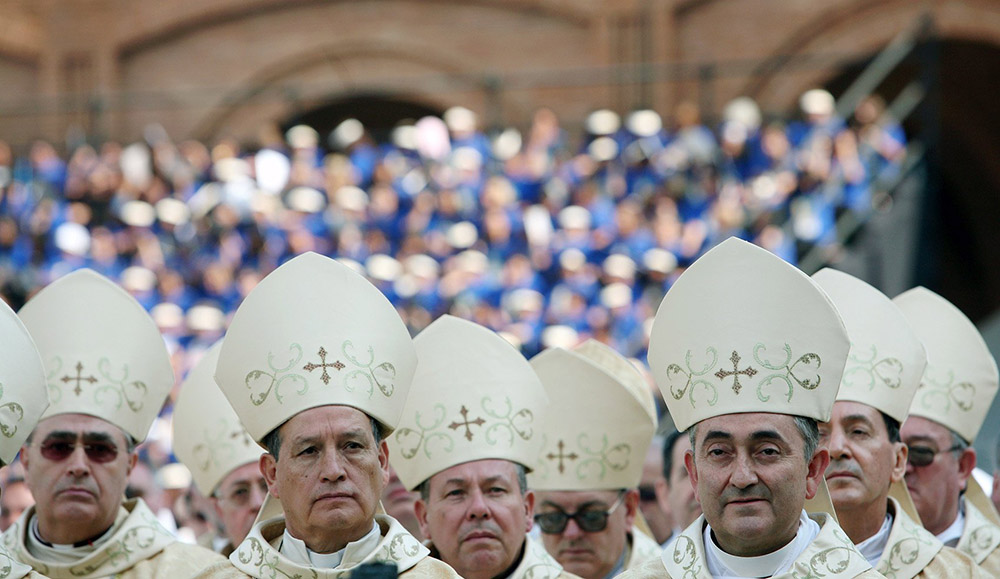
Bishops attend Mass with Pope Benedict XVI at the Basilica of the National Shrine of Our Lady Aparecida in Brazil in May 2007, as Benedict opened the Fifth General Conference of the Bishops of Latin America and the Caribbean. (CNS/Catholic Press Photo/Alessia Giuliani)
There are dioceses in Europe where the community elect their bishops (e.g., Austria) and laypeople lead parishes ministerially (e.g., Switzerland, Germany). Many parishes in the U.S. are also led ministerially and administratively by lay leaders. The archbishop of Lima, Peru, and the bishops of Venezuela are implementing parish reforms. Few Catholics know about these developments.
Why do you think that some sectors in the church in the United States still see synodality with suspicion?
I think that it has to do largely with how Catholics in the United States received the Second Vatican Council: an incomplete reception with more emphasis on structures, delimitation of ecclesial authority, and more emphasis on worship. In Latin America, the council was received in a more horizontal manner via Gaudium et Spes (option for the poor), Lumen Gentium (church, people of God), and Dei Verbum (a communal reading of the word of God).
This was crystalized in Medellín [Colombia, 1968], inspiring a pastoral de conjunto (more collaborative and inclusive ways of pastoral praxis). Yes, clericalism exists but there is more evidence of a desire to engage in horizontal ecclesial relationships.
We should not be surprised that many Catholics in the United States do not understand or simply refuse to embrace a synodal conversion. A clericalist mentality seems to permeate many of the ecclesial structures and pastoral practices. This applies both to the ordained and to lay ecclesial ministers who often act as if they were beyond the rest of the people of God or as corporate agents.
Therefore, a synodal perspective challenges the culture of clericalism and proposes a culture of dialogue and consensus. Synodality is countercultural. To understand synodality, we must return to the text and the spirit of Vatican II.
It is my observation that in many seminaries and faculties of theology the documents of the council receive little attention. How can pastoral leaders and theologians then understand synodality?
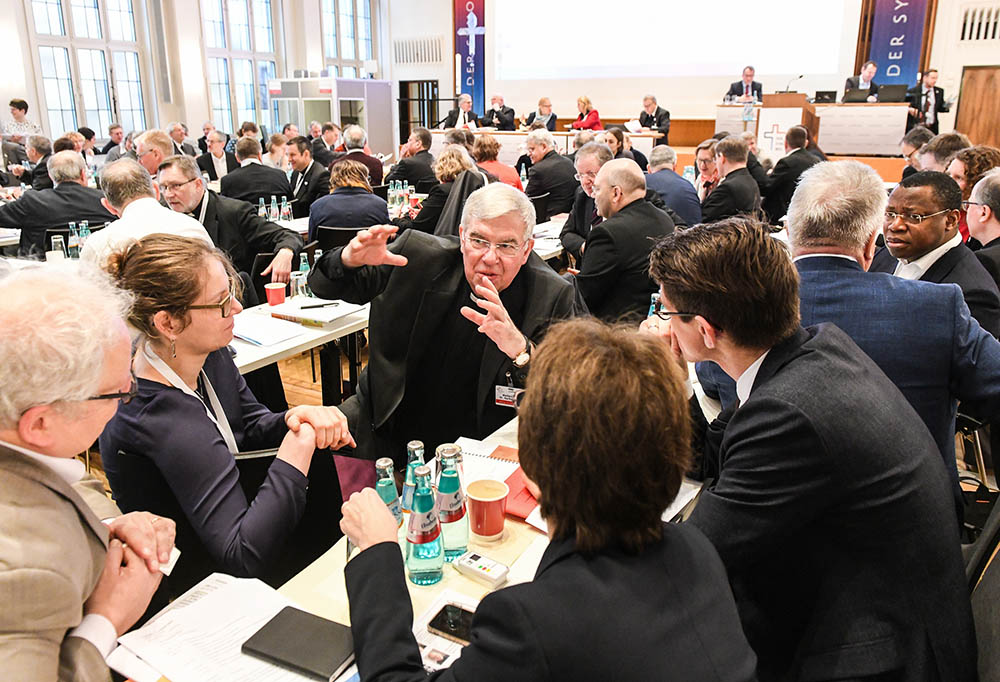
Auxiliary Bishop Karlheinz Diez of Fulda speaks with participants in Germany's synodal assembly at the Dominican monastery in Frankfurt, Germany, Jan. 31, 2020. (CNS/KNA/Harald Oppitz)
When Catholics in the United States follow synodal processes in Germany and in the Amazon region, for instance, many worry that local churches may engage in discernment processes that lead them to conclusions or decisions that perhaps other local churches may not be ready to consider or embrace. What do you think of this concern?
The concern echoes a pre-conciliar ecclesiological mentality that treated unity as equivalent to homogeneity. In its document "Synodality in the Life and Mission of the Church" (2018), the International Theological Commission reminds us that the first level in the exercise of synodal discernment is listening to the local churches and how the faith is expressed in different cultures and contexts.
That is what the conciliar decree Ad Gentes proposed. Seeking to impose ways of being Catholic that are theologically and culturally homogeneous is akin to arguing in favor of a new colonialism.
The local church is to express the church's universality in terms of what it believes and to affirm its diversity in terms of how that faith is inculturated through differentiated ecclesial forms and practices. Again, it is what Ad Gentes called for.
The synodal way challenges ecclesiologies that foster monoculturalism. Francis' 2020 exhortation Querida Amazonia reminds us that each local church must foster an incarnated ecclesial organization. This is why it is possible to have ministries that respond to the local needs of a culture or a territory, like the Amazon region or certain regions in Asia, that are not necessarily ministries common in North America or in certain communities in Africa.
This is what Jesuit Fr. Karl Rahner had in mind when referring to a "world church": The catholicity of the church becomes life in each local church in light of its particularity.
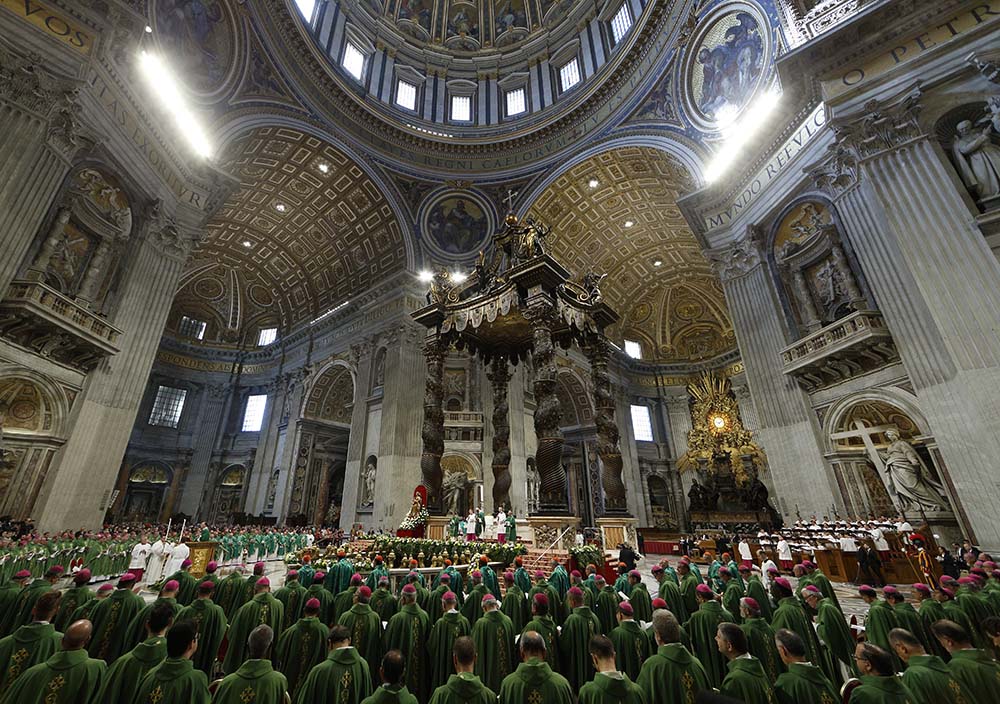
Pope Francis celebrates the concluding Mass of the Synod of Bishops for the Amazon at the Vatican Oct. 27, 2019. (CNS/Paul Haring)
What role is Rome to play in a synodal church?
Francis has helped us to retrieve the relevance of an ecclesiology of the local churches. Thus, Rome's role is not to impose a homogeneous ecclesial model. The bishop of Rome retains his primacy as bishop of Rome, and as such all bishops and the rest of the Catholic community are called to be in communion with him.
The church is a church of churches. This is the ecclesiological conviction that drives the methodology and process of the synod that will occur between October 2021 and October 2023.
Something new this time is that it will put into practice the first level of synodality. The synod starts with the local churches until the synodal assembly that will be celebrated in Rome in 2023. The meeting will be the convergence of all local churches and an expression of unity with the Bishop of Rome.
You served as Sr. Nathalie Becquart's academic adviser and directed her graduate thesis on the topic of synodality when she studied at Boston College. Now she is undersecretary of the Synod of Bishops, and the first vowed religious woman with a right to vote in such an ecclesial entity. How should we read this appointment?
It is a meaningful appointment, although its major impact is not what many U.S. Catholics and mass media venues often highlight. Many interpret her ability to vote in the Synod of Bishops as an exercise of lay power. That perspective may give the impression that the church is moving toward a model of representative democracy in which a majority — ordained or lay — may impose its will.
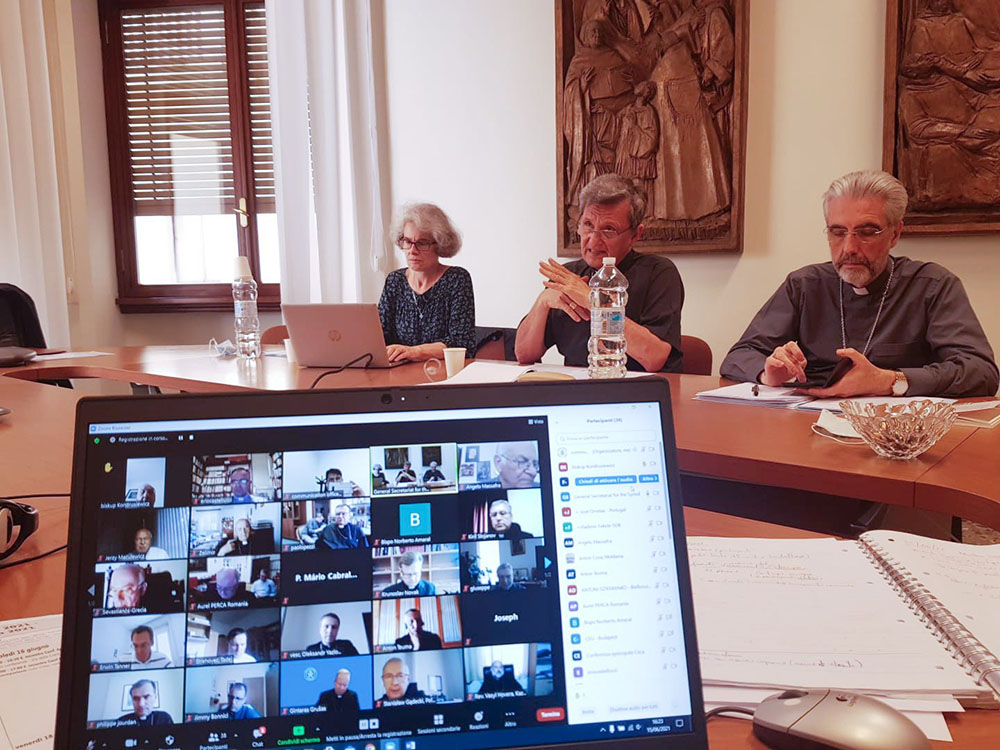
Leaders of the secretariat of the Synod of Bishops are pictured at the Vatican during an online meeting with presidents and general secretaries of national and regional bishops' conferences June 15. From left are: Xavière Missionary Sr. Nathalie Becquart, synod undersecretary; Cardinal Mario Grech, synod secretary; and Bishop Luis Marín de San Martín, synod undersecretary. (CNS/Courtesy of Synod of Bishops)
That analysis would be simplistic. There are several other lay women and men at the Vatican with juridical power that was traditionally reserved to bishops. To vote in these instances must be understood in a much wider context.
Sister Nathalie's appointment is an affirmation of the voice of ecclesial minorities and their representation in ecclesial processes. Only a culture of consensus can guarantee that minorities are recognized and included.
Remember that the Synod of Bishops is a collegial structure (i.e., among the body of bishops) and Sister Nathalie participates and cooperates with this collegial body as a layperson. It is a positive and necessary step, yet the structure of the synod remains collegial. Most likely that structure will not change, and there is no need to expect that.
What we need is a fresher model of being church, imagining and building new structures that reflect a more synodal model and that involve the laity much more in decision-making processes.
That is exactly what the Latin American bishops asked for in Aparecida. Sister Nathalie's presence, her way of being and thinking, her formation and experience, just like those of any other layperson in a similar position, require a new set of rules of engagement in terms of the internal interactions between the ordained and nonordained.
What she brings will enrich the discernment processes and highlight new perspectives bound to influence positively how decisions are made. This development did not happen via canon law but through praxis. It is not institutionalized, yet it set a precedent.
CELAM recently underwent a process of restructuring. Did that process incorporate a synodal vision?
From the time of its creation, the Latin American Episcopal Council (CELAM) has been a collegial organization, an entity through which the conferences of Catholic bishops of Latin America and the Caribbean collaborate. For several decades, the Latin American bishops have cultivated a type of collegiality rooted in an ecclesial culture defined by fraternity, solidarity, communality and affectivity, as Vatican II recommended.
The profoundly pastoral and missionary manner in which the church operates in the region should not surprise anyone. This has allowed more openness to the synodal way, compared to similar bodies of bishops in other parts of the world.
Thanks to this spirit, synodality permeates the practice of collegiality. What is new in the recent restructuring of CELAM is the intentional effort to institutionalize synodal structures.
Among such structures is the creation of the Ecclesial Conference of the Amazon Region (CEAMA). Although CEAMA is under the oversight of CELAM, it operates as an autonomous structure of synodal character. Its systems of governance involve bishops, other ordained ministers, vowed religious and laity.

Pilgrims travel in boats as they accompany the statue of Our Lady of Nazareth during an annual river procession and pilgrimage along the Apeu River to a chapel in Macapazinho, Brazil, Aug. 3, 2014. (CNS/Reuters/Ney Marcondes)
There are also representatives of organizations such as CLAR (Latin American religious) and Caritas, and ecclesial networks such as REPAM (Amazon region) and CLAMOR (immigrants). It is expected that processes of dialogue, discernment and decision-making in CELAM and CEAMA bring to life the potential of the synodal way of being church.
What do you recommend to understand and appreciate more these conversations on synodality?
First of all, humility and openness to listen. We need to overcome fears and prejudices when talking about these topics.
Read more, starting with a more in-depth study of the documents of the Second Vatican Council. Become familiar with the document of the International Theological Commission, "Synodality in the Life and Mission of the Church," which has not received sufficient attention, even among theologians. I also recommend taking part in the XVI Ordinary General Assembly of the Synod of Bishops (2021-23).
